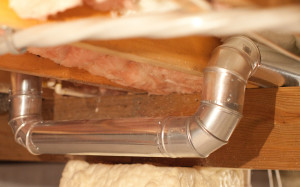Dryer Vent Ducting
Dryer vent ducting in a crawl space is an important element for ensuring that the moisture and warm air produced by your dryer are vented safely outside your home. If the dryer venting system isn’t properly installed or maintained, it can lead to a variety of issues, including fire hazards, moisture problems, and poor air quality.
Here’s a breakdown of key considerations for dryer vent ducting in a crawl space:


Proper Venting Material:
- Flexible Aluminum Ducting: This is one of the most common materials used for dryer vent ducts. It’s relatively easy to install but should be kept to a minimum in crawl spaces due to the potential for kinks or clogs. Over time, lint can build up, creating a fire hazard.
- Rigid Metal Ducting: This is often the preferred option for crawl spaces because it is more durable, resists damage better, and is less likely to collect lint. It is also less prone to kinking and allows for a smoother airflow, improving dryer efficiency.
- Plastic or PVC Ducting: This type of ducting should be avoided for dryer vents, as it can become a fire hazard. It’s not as durable as metal options and can accumulate lint more easily.
Ventilation & Airflow:
- Straight Path: The duct should be as straight as possible to prevent clogs. Each bend or curve in the duct increases the risk of lint buildup and reduces airflow.
- Proper Length: Dryer vents should not be too long. The longer the ducting, the harder it is for the air and lint to flow out. Most dryer manufacturers recommend keeping the duct length under 25 feet, with each bend reducing the maximum length.
- Venting Outside: The dryer vent should always exit outside the home, not into the crawl space or attic. Directing moist, warm air into an enclosed space like a crawl space can cause condensation, promote mold growth, and damage your foundation. The vent should discharge to the exterior of the house, away from the foundation and windows.
Avoiding Moisture & Mold Issues:
- If the dryer vent is routed through the crawl space, it’s essential to make sure the crawl space is well-ventilated to avoid trapping moisture. Excess moisture from the dryer vent could lead to dampness, which in turn could cause wood rot or mold growth in the crawl space. Keeping the area dry is key.
- Insulating the vent ducting can help prevent condensation inside the duct during colder months. If moist air condenses inside the duct, it could lead to mold or mildew growth. Proper insulation will help reduce this risk.